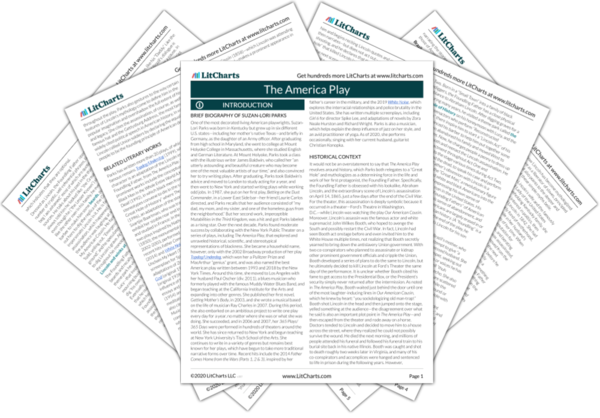One of the most decorated living American playwrights, Suzan-Lori Parks was born in Kentucky but grew up in six different U.S. states—including her mother’s native Texas—and briefly in Germany, as the daughter of an Army officer. After graduating from high school in Maryland, she went to college at Mount Holyoke College in Massachusetts, where she studied English and German Literature. At Mount Holyoke, Parks took a class with the illustrious writer James Baldwin, who called her “an utterly astounding and beautiful creature who may become one of the most valuable artists of our time,” and also convinced her to try writing plays. After graduating, Parks took Baldwin's advice and moved to London to study acting for a year, and then went to New York and started writing plays while working odd jobs. In 1987, she put on her first play,
Betting on the Dust Commander, in a Lower East Side bar—her friend Laurie Carlos directed, and Parks recalls that her audience consisted of “my dad, my mom, and my sister, and one of the homeless guys from the neighborhood.” But her second work,
Imperceptible Mutabilities in the Third Kingdom, was a hit and got Parks labeled as a rising star. Over the next decade, Parks found moderate success by collaborating with the New York Public Theater on a series of plays, including
The America Play, that explored and unraveled historical, scientific, and stereotypical representations of blackness. She became a household name, however, only with the 2002 Broadway production of her play
Topdog/Underdog, which won her a Pulitzer Prize and MacArthur “genius” grant, and was also named the best American play written between 1993 and 2018 by the New York Times. Around this time, she moved to Los Angeles with her husband Paul Oscher (div. 2011), a blues musician who formerly played with the famous Muddy Water Blues Band, and began teaching at the California Institute for the Arts and expanding into other genres. She published her first novel,
Getting Mother’s Body, in 2003, and she wrote a musical based on the life of musician Ray Charles in 2007. During this period, she also embarked on an ambitious project to write one play every day for a year, no matter where she was or what she was doing. She succeeded, and in 2006 and 2007, her
365 Plays/365 Days were performed in hundreds of theaters around the world. She has since returned to New York and begun teaching at New York University’s Tisch School of the Arts. She continues to write in a variety of genres but remains best known for her plays, which have begun to take more traditional narrative forms over time. Recent hits include the 2014
Father Comes Home from the Wars (Parts 1, 2 & 3), inspired by her father’s career in the military, and the 2019
White Noise, which explores the interracial relationships and police brutality in the United States. She has written multiple screenplays, including
Girl 6 for director Spike Lee, and adaptations of novels by Zora Neale Hurston and Richard Wright. Parks is also a musician, which helps explain the deep influence of jazz on her style, and an avid practitioner of yoga. As of 2020, she performs occasionally, singing with her current husband, guitarist Christian Konopka.
